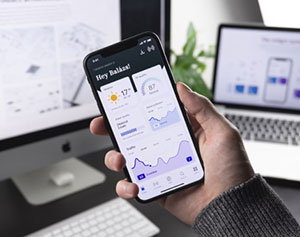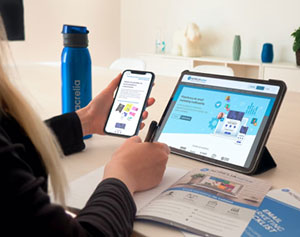Three Ways B2B Marketers Can Combat Rising Customer Acquisition Costs in 2025

Blog post By Paula Chiocchi on 2025-06-18
Inflation is everywhere and, yes, it’s impacting customer acquisition costs, too. Recent findings reported by MediaPost state that the cost of acquiring new customers is going up: 73% of B2C marketers say it's harder and more expensive than ever. B2B marketers are also feeling the impact. While the customer targets are different, many of the stress points are the same.
Customer acquisition campaigns have long been a specialty of ours at OMI, and we’ve helped the world’s largest brands find more customers (check out our case studies). Below are three key takeaways from our playbook —and actions B2B marketers can take now—to stay resilient and ROI-focused with customer acquisition.
- Connect Data to Reveal Real Opportunity
Siloed data remains one of the biggest obstacles to growth. MediaPost reports that marketers are “working with bloated tech stacks — 60% of marketing teams have 6-15 tools. So while companies are embracing cross-channel journeys, many are struggling to unify data.”
Removing the siloes from your customer and prospect data allows you to gain a holistic understanding of your target audience. This hinges upon seamless integration, but seamless integration in modern marketing environments is complex – because numerous data sources exist, including customer relationship management (CRM) data, real-time analytics, cross-channel analytics, telemetry data, third-party business contact data, and intent data. That’s why building APIs that connect data to popular tools and platforms to activate it quickly, easily and safely is critical for marketers today.
At OMI, one of our most common integrations involves layering intent data on top of B2B prospect contact data to enable reach to specific, qualified, and interested prospects—people who have already shown an interest in what you have to offer. The combined data can be integrated across an entire marketing technology stack and applied to targeted acquisition campaigns spanning email marketing, social networks, CTV, programmatic display ads, and more.
- Target with Precision, Engage with Relevance
Precision targeting is essential for reducing waste and improving results in your marketing efforts. Here are a few strategies we use to drive higher ROI and better outcomes with acquisition campaigns:
- Develop Robust Profiles: One of the top emerging data unification strategies we use to gain a robust understanding of prospects from a variety of perspectives is B2B2C data linkage. The premise behind it is this: today’s B2B decision-makers don’t just engage through work email. They stream CTV, scroll social platforms, and interact across a range of personal and professional touchpoints.
To unify those touchpoints, we start with a B2B buyer’s company IP address to uncover the titles of the buyers most likely to be the decision-makers within that organization. From there, we identify key consumer contact data such as mobile advertising ID, connected TV ID, and/or personal email. We then connect the dots between the professional role and the personal attributes and structure a campaign around the unified contact data. It's still a B2B offer, but you use consumer channels to promote and evangelize.
For the creative content, we customize messaging to the targeted decision-makers in all of the relevant ad-buying platforms, whether it’s META, TikTok, CTV, or a combination of these.
Combining intent data with more robust B2B2C prospect data will enhance targeting and relevance even further. For example, integrating behavioral intent signals (like topic research or buying stage) with firmographic and personal/lifestyle data, allows us to connect—across both personal and professional channels—with a VP of IT who has viewed the campaign content and is not just “a tech buyer,” but also currently interested in buying a new enterprise security solution for her organization.
The creative process includes looking at the age group of the recipient and aligning the creative to common generational attributes to better capture their interest.
- Target Buying Groups: We all know that B2B buying is done in groups today. B2B purchases now involve 11 decision-makers and more than 800 vendor reactions, according to ANA. Developing a strategy to build buyer cohorts and deliver personalized content at the appropriate time is critical: marketers must work to “create experiences unique to each individual buyer journey...AI email strategies should analyze intent signals across entire buying teams, identifying when accounts are researching solutions,” ANA reports. For example, if multiple team members from a company are exploring related technologies, generative AI can craft personalized emails informed by data about individual buyer priorities targeting different personas within a buying committee.
3. Prioritize Quality, Not Just Quantity
Recent research shows that B2B email lists decay at 28% per year: layoffs, job changes, company closures, and mergers all contribute to the churn. Beyond email, your entire repository of B2B data can degrade by up to 60% per year. The bottom line is, if you’re not actively maintaining your data, you’re likely wasting time and money on marketing campaigns that will never reach the right people.
That’s why we treat our award-winning OMI B2B prospect database as a Living File® —continuously updating it to reflect market shifts and business changes. For example, we leverage the true power of AI – which is its feedback loop—to continuously learn, iterate, and incorporate new AI-powered audience insights and profile attributes into the Living File® database, which fuels our custom audience-building services.
Our B2B Living File® licenses are crafted from our Master File, which is created through the processing of over 40 billion data signals per month. It provides access to accurate, actionable contacts across all key decision-making roles to fuel more effective customer acquisition campaigns. When leading brands keep coming back to us and our data to power their campaigns, we know we have the formula for success.
The Living File® database includes manager, director, and professional-level and above records with email/HEM, social URL, and other attributes. We also deliver the largest reach into the SMB marketplace and back up every client engagement with a 95% email validity guarantee for 30 days.
Lastly, remember that data quality starts with strong hygiene practices and trusted data partners. Ask us about our data cleansing services.
Final Takeaway: Invest in Your Data Foundation
Customer acquisition may be getting more expensive, but that doesn’t mean your marketing has to. By integrating clean, connected data, focusing on high-intent prospects, and optimizing reach through intelligent targeting, B2B marketers can stay ahead of rising costs while driving better ROI.
To learn how to cut waste and acquire more customers with clean, accurate data, contact our team at request@outwardmedia.com.
DOWNLOAD YOUR FREE ebook
At OMI, we believe good things happen when you share your knowledge. That's why we're proud to educate marketers at every level - in every size and type of organization - about the basics of email marketing and the contact data that powers it.
-
The Executive's 15-Minute Guide to Building a Successful Email Marketing Database
-
A 15-Minute Guide to Fortune 2,000 Businesses and Executives
-
Five Best Practices for Using Email Marketing to Target SMBs



